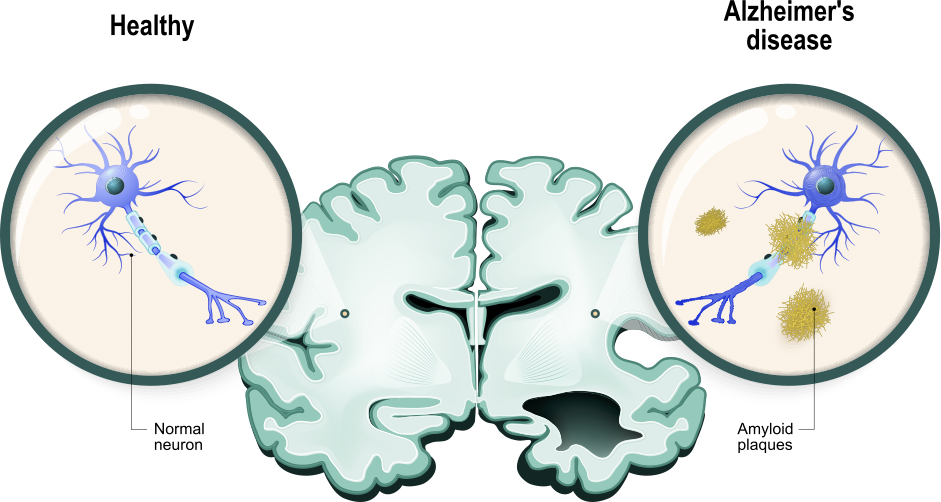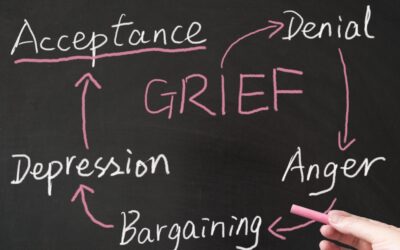Alzheimer’s Disease
What is Alzheimer’s disease?
Alzheimer’s disease is a progressive neurological disorder that affects the brain and is the most common cause of dementia. It is named after Dr. Alois Alzheimer, who first identified and described the condition in 1906.
Alzheimer’s disease gradually impairs cognitive functions, including memory, thinking, and behavior. It is characterized by the accumulation of two abnormal structures in the brain: beta-amyloid plaques and neurofibrillary tangles. These structures interfere with the normal functioning of brain cells and disrupt communication between them, leading to the symptoms of Alzheimer’s.
The exact cause of Alzheimer’s disease is not yet fully understood, but age is the greatest risk factor. Other factors that may contribute to the development of the disease include genetics, family history, certain genetic mutations, and lifestyle factors such as cardiovascular health, physical activity, and diet.

Symptoms of Alzheimer’s disease
The symptoms of Alzheimer’s disease progress over time and typically include:
- Memory loss: Individuals may have difficulty remembering recently learned information, as well as important dates or events.
- Cognitive decline: People with Alzheimer’s may experience difficulty with thinking, problem-solving, language, and judgment.
- Behavioral changes: This may include depression, apathy, social withdrawal, mood swings, and changes in personality.
- Disorientation: Individuals may become disoriented in time and space, getting lost in familiar places.
- Decline in self-care: As the disease progresses, individuals may struggle with basic tasks such as dressing, bathing, and feeding themselves.
How Common is Alzheimers Disease?
The prevalence of Alzheimer’s disease varies depending on the population and the age group being considered. According to estimates from the World Health Organization (WHO), globally, around 50 million people have dementia, with Alzheimer’s disease accounting for 60-70% of those cases.
To provide a broader perspective, here are a few statistics on the prevalence of Alzheimer’s disease:
- United States: In the United States, it is estimated that around 6.2 million individuals aged 65 and older have Alzheimer’s disease. This number is expected to rise to nearly 13 million by 2050, due to the aging population.
- Global estimates: The number of people living with Alzheimer’s disease worldwide is projected to reach 82 million by 2030 and 152 million by 2050, assuming no medical breakthroughs to prevent or cure the disease.
- Age-related risk: The risk of developing Alzheimer’s disease increases with age. It is relatively rare in people under 65, but the prevalence rises significantly as individuals get older. Beyond the age of 65, the risk doubles approximately every five years.
It’s important to note that these figures are estimates, and the actual prevalence may vary due to factors such as underdiagnosis, differences in diagnostic criteria, and variations in data collection methodologies across different countries and studies.
How is Alzheimer’s disease diagnosed?
The diagnosis of Alzheimer’s disease involves a comprehensive evaluation that includes medical history assessment, physical examination, cognitive and neurological testing, and sometimes imaging and laboratory tests. Here are the key steps and methods used in diagnosing Alzheimer’s disease:
- Medical history and assessment: The doctor will gather information about the individual’s symptoms, their onset, progression, and any family history of dementia or Alzheimer’s disease. They may also inquire about the presence of other medical conditions that could contribute to cognitive decline.
- Cognitive and neurological testing: Various tests are conducted to assess memory, thinking, language, attention, and problem-solving skills. These tests can help identify cognitive impairments and determine the severity. They may include the Mini-Mental State Examination (MMSE) or other similar cognitive assessment tools.
- Functional assessment: The doctor will evaluate the individual’s ability to perform daily activities and self-care tasks. This assessment helps determine the impact of cognitive decline on their daily life and functioning.
- Imaging tests: Brain imaging techniques, such as magnetic resonance imaging (MRI) or positron emission tomography (PET), may be used to rule out other causes of cognitive impairment, visualize changes in brain structure or detect the presence of amyloid plaques and neurofibrillary tangles associated with Alzheimer’s disease.
- Laboratory tests: Blood tests may be conducted to rule out other medical conditions that can cause similar symptoms, such as thyroid problems, vitamin deficiencies, or infections.
- Neuropsychological testing: In some cases, more detailed neuropsychological assessments may be performed to evaluate specific cognitive domains and provide a comprehensive profile of cognitive strengths and weaknesses.
It’s important to note that a definitive diagnosis of Alzheimer’s disease can only be made with certainty through a brain autopsy after death. However, the diagnostic process aims to identify the most likely cause of the individual’s symptoms based on clinical evaluation and tests.
Treatment
While there is currently no cure for Alzheimer’s disease, there are treatment options available that can help manage symptoms, slow down the progression of the disease, and improve the quality of life for individuals with Alzheimer’s. The treatment approach for Alzheimer’s disease typically involves a combination of the following:
- Medications: Several medications are approved for the treatment of Alzheimer’s disease. These medications work by regulating neurotransmitters in the brain and can help improve cognitive function, manage behavioral symptoms, and slow down the progression of the disease. Commonly prescribed medications include cholinesterase inhibitors (such as donepezil, rivastigmine, and galantamine) and memantine, which is an N-methyl-D-aspartate (NMDA) receptor antagonist.
- Supportive care: Alongside medication, supportive care plays a crucial role in managing Alzheimer’s disease. This includes creating a structured and supportive environment, establishing routines, providing cognitive stimulation activities, and offering emotional support to both the individual with Alzheimer’s and their caregivers.
- Lifestyle interventions: Certain lifestyle factors can influence the prevention and progression of Alzheimer’s disease. Encouraging regular physical exercise, maintaining a healthy diet (such as the Mediterranean diet), promoting social engagement, and ensuring adequate sleep can all contribute to overall well-being and potentially slow down cognitive decline.
- Cognitive interventions: Cognitive stimulation therapy, cognitive rehabilitation, and other forms of cognitive training can be beneficial in managing symptoms and improving cognitive function. These interventions involve structured activities and exercises that aim to enhance memory, thinking, and problem-solving skills.
- Behavioral and psychological interventions: Managing behavioral and psychological symptoms of Alzheimer’s disease (such as agitation, aggression, depression, and sleep disturbances) is important for the well-being of individuals with the condition. Non-pharmacological interventions, such as behavioral therapy, music therapy, art therapy, and reminiscence therapy, can help address these symptoms.
It’s essential for individuals with Alzheimer’s disease and their caregivers to work closely with healthcare professionals to determine the most appropriate treatment plan based on the individual’s specific needs and stage of the disease. Regular monitoring and follow-up evaluations are necessary to assess the effectiveness of treatments and make any necessary adjustments.
Purpose brings light to the darkness
The sole purpose of human existence is to kindle a light in the darkness of mere being. Carl Jung In my early years, I was never curious about why I existed. But if I had, I assume I might have concluded it was nothing more than just taking up space. Fast forward to...
The Hum of Hope
“We don’t believe something by merely saying we believe it, or even when we believe that we believe it. We believe something when we act as if it were true.” -Dallas Willard There is a hum that is playing in the background of your mind. You might not think so, but if...
Radical Acceptance
“Pain is not wrong. Reacting to pain as wrong initiates the trance of unworthiness. The moment we believe something is wrong, our world shrinks and we lose ourselves in the effort to combat the pain.”― Tara Brach, Radical Acceptance: Embracing Your Life With the Heart...
Self-Discipline Isn’t Enough
All the energy in the universe is evenly present in all places at the same time. We don’t get energy, we release energy. And the triggering mechanism to release energy is desire. When you have a strong desire to do something, you will always have the energy to do it.”...
New Year, new you…..stop the insanity….
“Self-discipline is often disguised as short-term pain, which often leads to long-term gains. The mistake many of us make is the need and want for short-term gains (immediate gratification), which often leads to long-term pain.” ― Charles F. Glassman, Brain Drain –...
Spending Time in Nature: Benefits & How to Get Started
In the digital age, people are glued to their phones at all hours of the day. Factor in sedentary lifestyles, and we are damaging our mental and physical well-being. This is why we all need to get out—we mean this in the kindest way possible. Spend time outdoors,...
Processed Foods: Balancing Convenience, Safety, and Nutrition
Today, people are eating more processed food compared to the past few decades—and it’s easy to see why. It’s conveniently available, making it an absolute time-saver in the kitchen. It’s also usually cheaper and tastier than whole, natural foods while offering a...
2023 You, Is Just Fine……
“The key to finding happiness in this life is realizing that the only way to overcome is to transcend; to find happiness in the simple pleasures, to master the art of just being.”― Brianna Wiest I bought into the hype. Yup, about two weeks ago, I started my list of...






